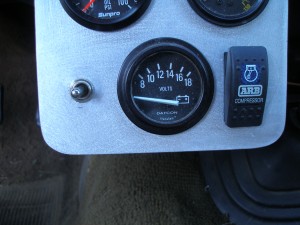By Tony K
Having a voltmeter in the dash was always a nice feature, much better than the proverbial idiot light that only reveals itself when it is pretty much too late to do anything about it. But the factory gauge in the dash does have some drawbacks. Having to turn the key on for a reading is a bit of a pain and just how accurate is the gauge. And adding a second battery added even more complications. But my biggest concern with the added battery was knowing just what condition each of the batteries were in. All the factory gauge does is tell me the voltage while they are both hooked up in parrellel.
The only way to really know just how much my batteries have left was a voltmeter. But what I needed was a way to check the batteries individually as well as a way that didn’t include having to turn on the ignition key. And I really didn’t like the idea of having two individual voltmeters even if the dash space was available. The driving force behind the need for this is my fridge. When we go camping, our fridge needs power but not at the expense of the ability to start my rig the next day.
 What I came up with is extremely simple and has no draw on the system when it is not being used. All it takes is a bit of wire, a single voltmeter and a toggle switch. And let me start by saying that not all toggles are the same. My toggle switch is a bit different as it has three positions. In the center is off and to either side there is a momentary on. Essentially it is springloaded to the off position, this means you have to move and hold it to one side to activate that side of the circuit. Hold it to the left and you get a reading for the drivers side battery and to the right is the passenger side. In the Cole Hersey catalog it is listed as a momentary on- off -momentary on switch. If you don’t use this type of toggle you will have a small draw on the system at all times.
What I came up with is extremely simple and has no draw on the system when it is not being used. All it takes is a bit of wire, a single voltmeter and a toggle switch. And let me start by saying that not all toggles are the same. My toggle switch is a bit different as it has three positions. In the center is off and to either side there is a momentary on. Essentially it is springloaded to the off position, this means you have to move and hold it to one side to activate that side of the circuit. Hold it to the left and you get a reading for the drivers side battery and to the right is the passenger side. In the Cole Hersey catalog it is listed as a momentary on- off -momentary on switch. If you don’t use this type of toggle you will have a small draw on the system at all times.
To make this all work, a wire is run from the hot side of each battery (or in my case on the terminals on the back of my main battery switch) to the outboard terminals of the switch. Center of the switch runs to the 12V connection of the voltmeter. Holding the toggle to one side or the other now activates the voltmeter and gives you the reading for the choosen battery. Releasing it puts it back in the off position. You can now check the voltage of an individual battery while parked with the key off to see how much juice is left or when running to make sure it is getting charged.
And just so the lights of the gauge don’t make me nervous with a voltmeter on zero, the lights are wired into the center post of the switch. This way the light only comes on when you are checking a battery.
This set up has prevented me from killing a battery on more than one occasion. And chalk up another one for clean simple and bulletproof.

